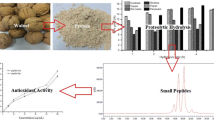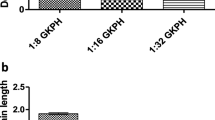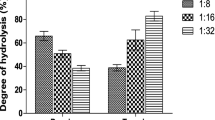Abstract
To study the influence of degree of hydrolysis (DH) on antioxidant properties of peanut peptides, the peanut meal was fermented by Bacillus subtilis. The fermentation time was 48, 72, and 96 h, respectively, to prepare peanut peptides at different degree of hydrolysis. The peanut peptides (11.18, 16.20, and 21.41% of DH, respectively) were extracted from fermentation liquid. The antioxidant properties of these peanut peptides were evaluated based on DPPH· radical (1,1-Diphenyl-2-picrylhydrazyl radical) scavenging activity, superoxide anion-scavenging activity, reducing power, metal-chelating activity, and inhibition of linoleic acid autooxidation. Peanut peptides (21.41% of DH) at 1 mg/mL exhibited 80.86 and 29.35% of scavenging concentration percent on DPPH· and superoxide anion radical, respectively. In addition, the reducing power of peanut peptides was 0.368 at 2 mg/mL, and they possessed 76.32% of Fe2+-chelation ability at 2 mg/mL and 63.75% of inhibition of linoleic acid autooxidation at 0.8 mg/mL. The antioxidant activities of the peanut peptides (21.41% of DH) were stronger compared with others (11.18 and 16.20% of DH), and this indicated the antioxidant activities of peanut peptides increased with increasing DH (p < 0.05). To know much about the peanut peptides, they were subjected to amino acid analysis and determination of molecular weight distribution. Some acidic amino acids and essential amino acids were found, and the average molecular weight distributions were concentrated in <1,400 Da (86.96%). Combined with the results of the amino acid profiles, the peanut peptides were believed to have high nutritive value besides antioxidant activities.






Similar content being viewed by others
References
Gilbert DL (2000) Fifty years of radical ideas. An NY Acad Sci 899:1
Wettasinghe M, Shahidi F (2000) Scavenging of reactive-oxygen species and DPPH free radicals by extracts of borage and evening primrose meals. Food Chem 70:17–26
Fang YZ, Yang S, Wu GY (2002) Free radicals, antioxidants and nutrition. Nutr 18:872–879
Wang JS, Zhao MM, Zhao QZ, Jiang YM (2007) Antioxidant properties of papain hydrolysates of wheat gluten in different oxidation systems. Food Chem 101:1658–1663
Abdel-Hameed ES (2009) Total phenolic contents and free radical scavenging activity of certain Egyptian Ficus species leaf samples. Food Chem 114:1271–1277
Halliwell B (1995) Oxygen radical, nitric oxide and human inflammatory joints disease. Ann Rheum Dis 54:505–510
Nilsson J, Stegmark R, Akesson B (2004) Total antioxidant capacity in different pea (Pisum sativum) varieties after blanching and freezing. Food Chem 86:501–507
Prakash D, Singh BN, Upadhyay G (2007) Antioxidant and free radical scavenging activities of phenols from onion (Allium cepa). Food Chem 102:1389–1393
Gülçin I, Huyut Z, Elmastas M, Aboul-Enein HY (2010) Radical scavenging and antioxidant activity of tannic acid. AR J Chem 3:43–53
Velioglu YS, Mazza G, Gao L, Oomah BA (1998) Antioxidant activity and total phenolics in selected fruits, vegetables and grain products. J Agric Food Chem 46:4113–4117
Temple NJ (2000) Antioxidant and disease: more questions than answers. Nutr Res 20:449–459
Tsaliki E, Lagouri V, Doxastakis G (1999) Evaluation of the antioxidant activity of lupin seed flour and deriatives (Lulinus albus ssp. Graecus). Food Chem 65:71–75
Hettiarachchy NS, Glen KC, Gnanasambandam R, Johnson MG (1996) Natural antioxidant extract from fenugreek (Trigonella foenumgraecum) for ground beef patties. J Food Sci 61:516–519
Amarowicz R, Shahidi F (1996) Antioxidant activity of peptide fractions of capelin protein hydrolysates. Food Chem 58:335–359
Sakanaka S, Tachinana Y, Ishihara N, Juneja LR (2004) Antioxidant activity of egg-yolk protein hydrolysate in a linoleic acid oxidation system. Food Chem 86:99–103
Je JY, Park PJ, Kim SK (2005) Antioxidant activity of a peptide isolated from Alaska Pollack (Theragra chalcogramma) frame protein hydrolysate. Food Res In 38:45–50
Kim SY, Je JY, Kim SK (2007) Purification and characterization of antioxidant peptide from hoki (Johnius belengerii) frame protein by gastrointestinal digestion. J Nat Biochem 18:31–38
Li YH, Jiang B, Zhang T, Mu WM, Liu J (2008) Antioxidant and free radical-scavenging activities of chickpea protein hydrolysate (CPH). Food Chem 106:444–450
Ren JY, Zhao MM, Shi J, Wang JS, Jiang YM, Cui C, Kakuda Y, Xue SJ (2008) Purification and identification of antioxidant peptides from grass carp muscle hydrolysates by consecutive chromatography and electroionization-mass spectrometry. Food Chem 108:727–736
Xie ZJ, Huang JR, Xu XM, Jin ZY (2008) Antioxidant activity of peptides isolated from alfalfa leaf protein hydrolysate. Food Chem 111:370–376
Zhang JH, Zhang H, Wang L, Guo XN, Yao HY (2009) Antioxidant activities of the rice endosperm protein hydrolysate: identification of the active peptide. Eur Food Res Technol 229:709–719
Byun HG, Lee JK, Park HG, Jeon JK, Kim SK (2009) Antioxidant peptides isolated from the marine rotifer, Brachionus rotundiformis. Process Biochem 44:842–846
Peng XY, Xiong YL, Kong BH (2009) Antioxidant activity of peptide fractions from whey protein hydrolysates as measured by electron spin resonance. Food Chem 113:196–201
Bougatef A, Nedjar-Arroume N, Manni L, Ravallec R, Barkia A, Guillochon D, Nasri M (2010) Purification and identification of novel antioxidant peptides from enzymatic hydrolysates of sardinelle (Sardinella aurita) by-products proteins. Food Chem 118:559–565
Wu HW, Wang Q, Ma TZ, Ren JJ (2009) Comparative studies on the functional properties of various protein concentrate preparation of peanut protein. Food Res In 42:343–348
Peanut web of China (2008) http://www.cnpeanut.com
Steinkraus KH (1997) Classification of fermented foods: worldwide review of household fermentation techniques. Food Contl 8:311–317
Zhu YP, Fan JF, Cheng YQ, Li LT (2008) Improvement of the antioxidant activity of Chinese traditional fermented okara (Meitauza) using Bacillus subtilis B2. Food Contl 19:654–661
Yu B, Lu ZX (2005) Determination of degree of hydrolysis of soybean peptides produced by microorganism fermentation. Food Sci 26:104–107
Shao JL, Li QW, Dong BS, Liu HC, Su JH (2008) Determination of total free-amino acid in tea by ninhydrin colorimetry. Chn Food Addit 2:162–165
Orhan I, Kartal M, Abu-Asaker M, Senol FS, Yilmaz G, Sener B (2009) Free radical scavenging properties and phenolic characterization of some edible plants. Food Chem 114:276–281
Shi JY, Gong JY, Liu JE, Wu XQ, Zhang Y (2009) Antioxidant capacity of extract from edible flowers of Prunus mume in China and its active components. LWT-Food Sci Technol 42:477–482
Xiao HS, He WJ, Fu WQ, Cao HY, Fan ZN (1999) A spectrophotometer method testing oxygen radicals. Prog Biochem Biophys 26:180–182
Kaur R, Arora S, Singh B (2008) Antioxidant activity of the phenol rich fractions of leaves of Chukrasia tabularis A. Juss. Bioresour Technol 99:7692–7698
Giménez B, Alemán A, Montero P, Gómez-Guillén MC (2009) Antioxidant and functional properties of gelatin hydrolysates obtained from skin of sole and squid. Food Chem 114:976–983
Osawa T, Namiki M (1985) Natural antioxidant isolated from eucalyotus leaf waxes. J Agric Food Chem 33:777–780
Chen HM, Muramoto K, Yamauchi F (1995) Structural analysis of antioxidative peptides from soybean β-conglycinin. J Agric Food Chem 43:574–578
Mosquera OM, Correa YM, Buitrago DC, Niö J (2007) Antioxidant activity of twenty five plants from Colombian biodiversity. Mem I Oswaldo Cruz 102:631–634
Dorman HJD, Peltoketo A, Hiltunen R, Tikkanen MJ (2003) Characterization of the antioxidant properties of deodorized aqueous extracts from selected Lamiaceae Herbs. Food Chem 83:255–262
Duh PD (1998) Antioxidant activity of burdock (Arctium lappa Linne): its scavenging effect on free-radical and active oxygen. J Am Oil Chem Soc 75:455–461
Ferreira ICFR, Baptista P, Vilas-Boas M, Barros L (2007) Free-radical scavenging capacity and reducing power of wild edible mushrooms from northeast Portugal: Individual cap and stipe activity. Food Chem 100:1511–1516
Cumby N, Zhong Y, Nack M, Shahidi F (2008) Antioxidant activity and water-holding capacity of canola protein hydrolysates. Food Chem 109:144–148
Liu Q, Kong BH, Xiong YL, Xia XF (2010) Antioxidant activity and functional properties of porcine plasma protein hydrolysate as influenced by the degree of hydrolysis. Food Chem 118:403–410
Je JY, Qian ZJ, Kim SK (2007) Antioxidant peptide isolated from muscle protein of Bullfrog, Rana catesbeiana Shaw. J Med Food 10:401–407
Pan YM, Zhang XP, Wang HS, Liang Y, Zhu JC, Li HY, Zhang Z, Wu QM (2007) Antioxidant potential of ethanolic extract of Polygonum cuspidatum and application in peanut oil. Food Chem 105:1518–1524
Wiseman H, Halliwell B (1996) Damage to DNA by reaction oxygen and nitrogen species: Role of inflammatory disease and progression to cancer. Biochem J 313:17–29
Rajapakse N, Mendis E, Byun HG, Kim SK (2005) Purification and in vitro antioxidative effects of giant squid muscle peptides on free radical-mediated oxidative systems. J Nutr Biochem 16:562–569
Saiga A, Tanabe S, Nishimura T (2003) Antioxidant activity of peptides obtained from porcine myofibrillar proteins by protease treatment. J Agric Food Chem 51:3661–3667
Park PJ, Jung WK, Nam KS, Shahidi F, Kim SK (2001) Purification and characterization of antioxidative peptides from protein hydrolysate of lecithin-free egg yolk. J Am Oil Chem Soc 78:651–656
Guo H, Kouzuma Y, Yonekura M (2009) Structures and properties of antioxidative peptides derived from royal jelly protein. Food Chem 113:238–245
Author information
Authors and Affiliations
Corresponding author
Rights and permissions
About this article
Cite this article
Zhang, Y., Zhang, H., Wang, L. et al. Influence of the degree of hydrolysis (DH) on antioxidant properties and radical-scavenging activities of peanut peptides prepared from fermented peanut meal. Eur Food Res Technol 232, 941–950 (2011). https://doi.org/10.1007/s00217-011-1466-0
Received:
Revised:
Accepted:
Published:
Issue Date:
DOI: https://doi.org/10.1007/s00217-011-1466-0




